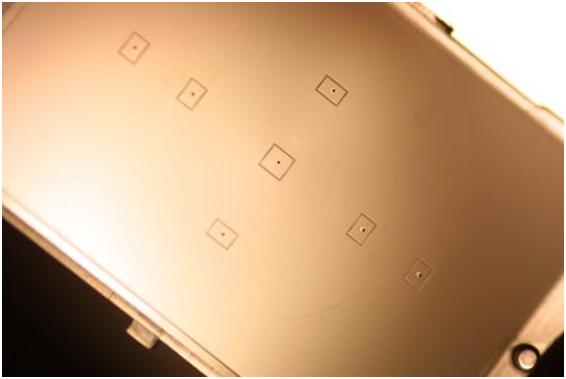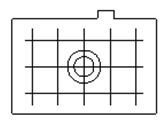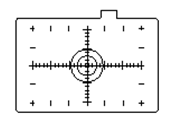The standard AUTO-FOCUS screen on a DSLR may look like

The older style manual focus camera's had a focus screen that is viewed through the view-finder that helps with fine level of focusing,
You can retro-fit these screens to later more modern DSLR camera – I am hopefully going to purchase a "SPLIT-SCREEN" focus screen for my 500d.
A quick summary (full credit to http://www.camerahacker.com/Tools/Viewfinder_Screens.shtml) is given below:
Microprism
| Microprism focusing screen gets its name from placing many tiny prisms on the focusing screen. When the subject is not in focus, the tiny prisms show up in black and white dotted pattern. When the subject is in focus, the prisms blend in with the surrounding light so that you don't see them any more. Although this system still forces you to look closely at the screen, it makes the task slightly easier. |
Split – Image
| The split-image focusing screen is probably one of the most useful manual focusing screens. A split-image focusing screen has a split circle in the middle. Usually the split is Horizontal. But there are vertical and diagonal focusing screens out there as well. In fact, for some camera systems, there is a "cross-split" type that has both vertical and horizontal splits. The split divides your image in half. If your subject is not in focus, the two images does not line up. With the horizontal split, one half of the circle is shifted to the left, while the other half is shifted to the right. By aiming the circle on your subject's edge, it is very easy to see whether the edges line up. Instead of looking at whether the image is blurry, adjust the focus until the edge lines up, then you'll know the subject is sharp |
Grid
| Although most of this article talked about manual focus screens, there are several viewfinder screens used for other purposes. One such screen is the grid screen. The grid screen has several horizontal and vertical lines on it. These lines form a grid. The grid is very useful for composing the scene. You can easily see if an object is on a line, off a line, or at the intersection of a line. It's easy to put things where specified by the rule of thirds. You can see if straight lines are truly vertical or horizontal in the image frame. Architecture photographers find the grid screen particularly convenient. |
Scale
| The scale screen is very similar to the grid screen. But instead of forming a grid, the lines on the viewfinder screen form a graph-like scale with the origin in the center of the screen. The scale could be in millimeters, inches, or any other measurement unit. The scale screen is particular useful for macro and scientific photography where the amount of magnification is significant. |
A quick google search unearthed :
http://www.katzeyeoptics.com/item--Canon-450D-500D-Focusing-Screen--prod_450D.html
A quick search on ebay found :
http://cgi.ebay.co.uk/Dual-45-Split-image-Focus-Screen-Canon-450D-500D-O5E2-/190361800748?pt=UK_Photography_DigitalCamAccess_RL&hash=item2c5272902c#ht_3087wt_934




No comments:
Post a Comment
leave a comment on PhotographyByFai.blogspot.com